CHEVROLET BLAZER 1995 2.G Service Manual
Manufacturer: CHEVROLET, Model Year: 1995, Model line: BLAZER, Model: CHEVROLET BLAZER 1995 2.GPages: 380, PDF Size: 20.04 MB
Page 41 of 380
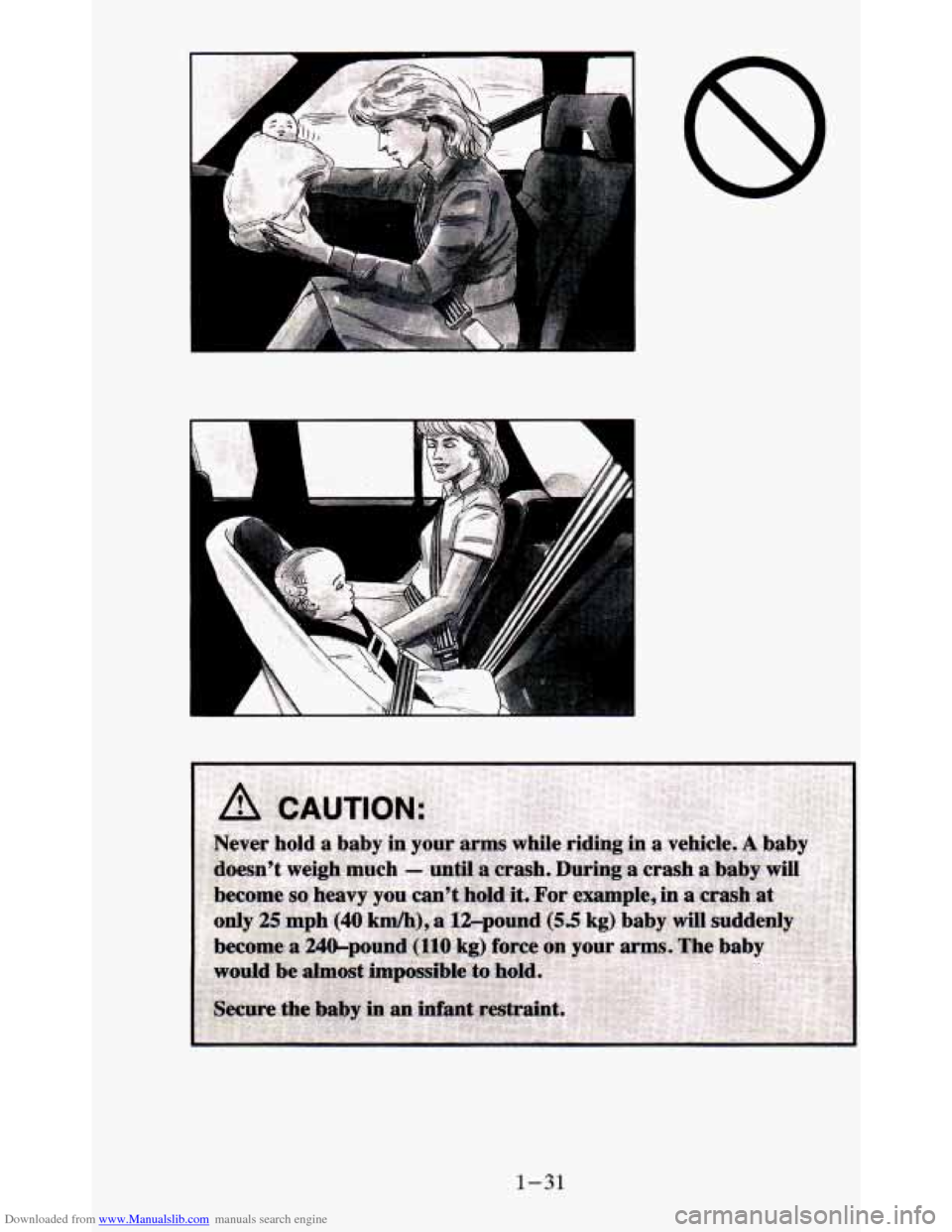
Downloaded from www.Manualslib.com manuals search engine -
1-31
Page 42 of 380
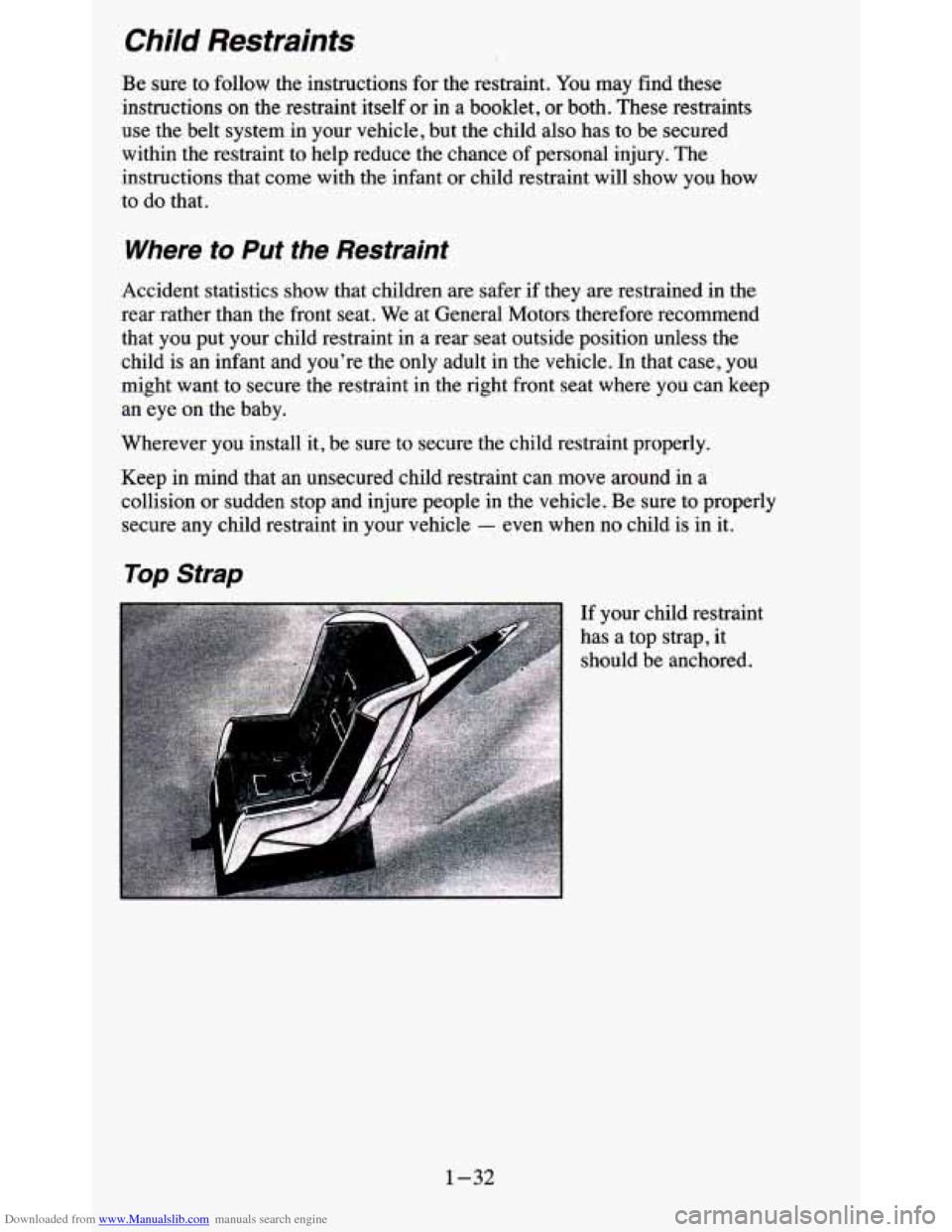
Downloaded from www.Manualslib.com manuals search engine Child Restraints
Be sure to follow the instructions for the restraint. You may find these
instructions on the restraint itself or in a booklet, or both.\
These restraints
use the belt system in your vehicle, but the child also has to be secured
within the restraint to help reduce the chance of personal injury. The
instructions that come with the infant or child restraint will \
show you how
to do that.
Where to Put the Restraint
Accident statistics show that children are safer if they are restrained in the
rear rather than the front seat. We at General Motors therefore recommend
that you put your child restraint in a rear seat outside posi\
tion unless the
child is an infant and you’re the only adult
in the vehicle. In that case, you
might want to secure the restraint in the right front seat wh\
ere you can keep
an eye on the baby.
Wherever you install it, be sure to secure the child restraint properly.
Keep in mind that an unsecured child restraint can move around\
in
a
collision or sudden stop and injure people in the vehicle. Be sure to properly
secure any child restraint in your vehicle
- even when no child is in it.
Top Strap
If your child restraint
has a top strap, it
should be anchored.
1-32
Page 43 of 380
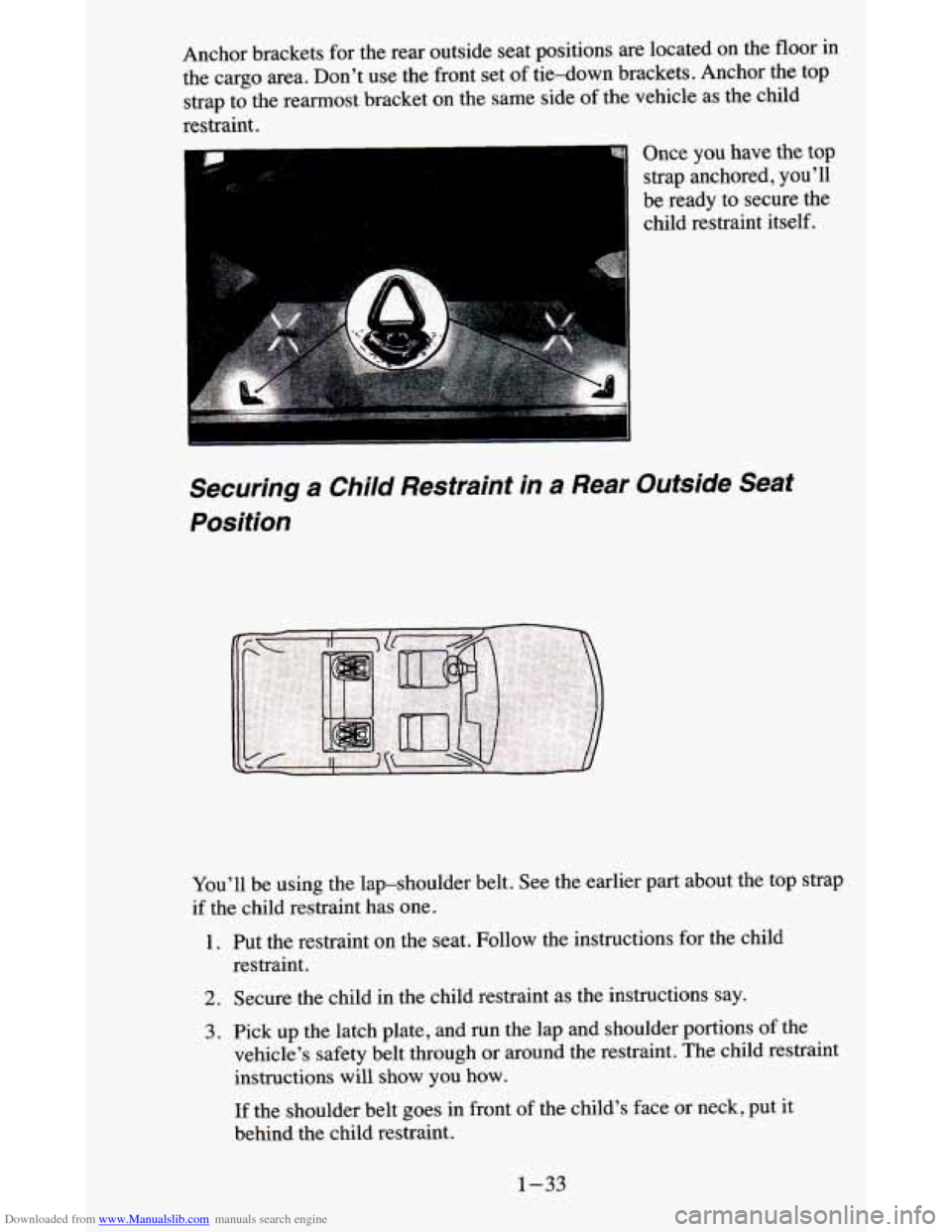
Downloaded from www.Manualslib.com manuals search engine Once you have the top
strap anchored,
you’ll
be ready to secure the
child restraint itself.
You’ll be using the lap-shoulder belt. See the earlier
part about the top strap
if the child restraint has one.
2. Secure the child in the child restraint as the instructions say.
3. Pick up the latch plate, and run the lap and shoulder portions of the
vehicle’s safety belt through or around the restraint. The child restraint
instructions will show
you how.
If the shoulder belt goes in front of the child’s face or neck, put it
behind
the child restraint.
1-33
Page 44 of 380
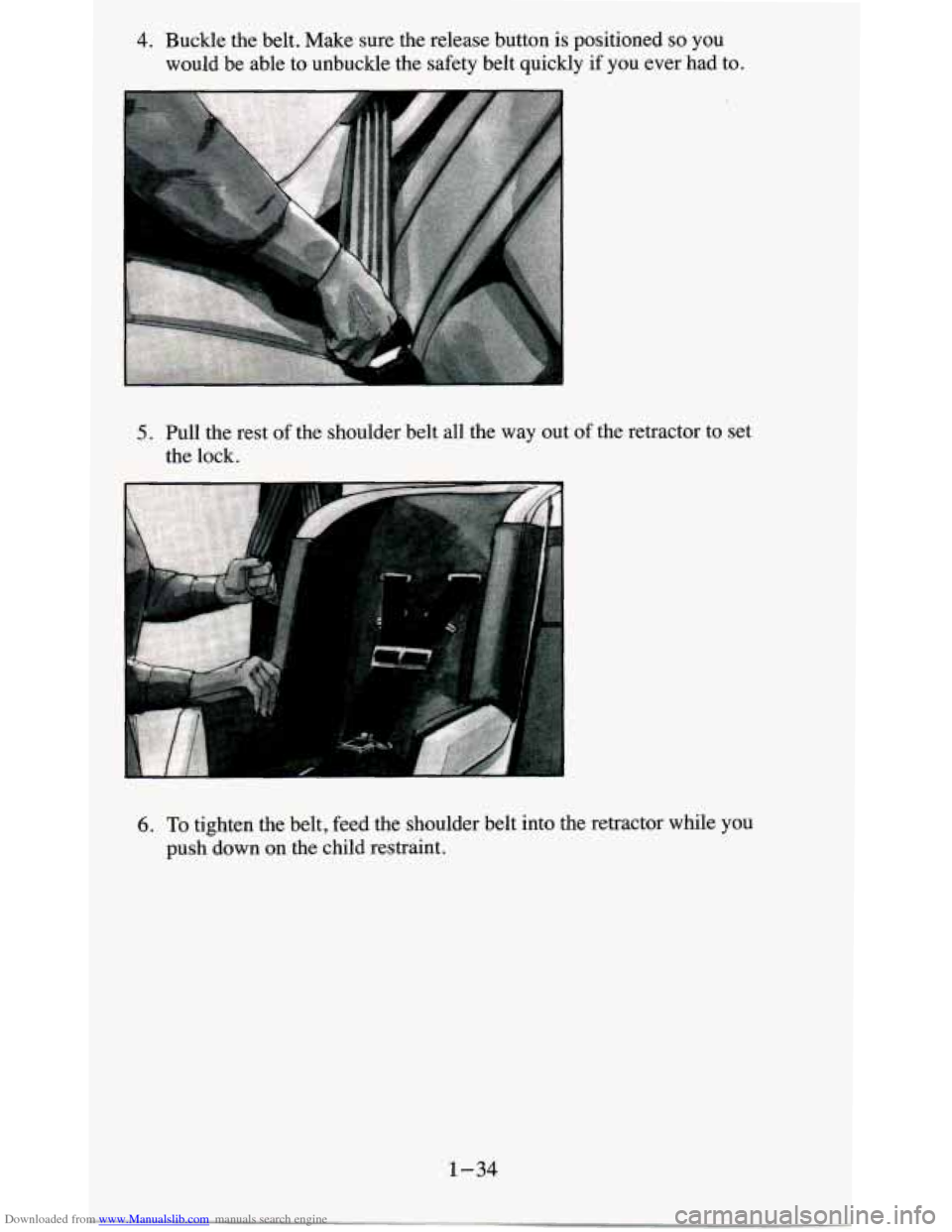
Downloaded from www.Manualslib.com manuals search engine 4. Buckle the belt. Make sure the release button is positioned so you
would be able to unbuckle the safety belt quickly if you ever had to.
6. To tighten the belt, feed the shoulder belt into the retractor while you
push down on the child restraint.
1-34
Page 45 of 380
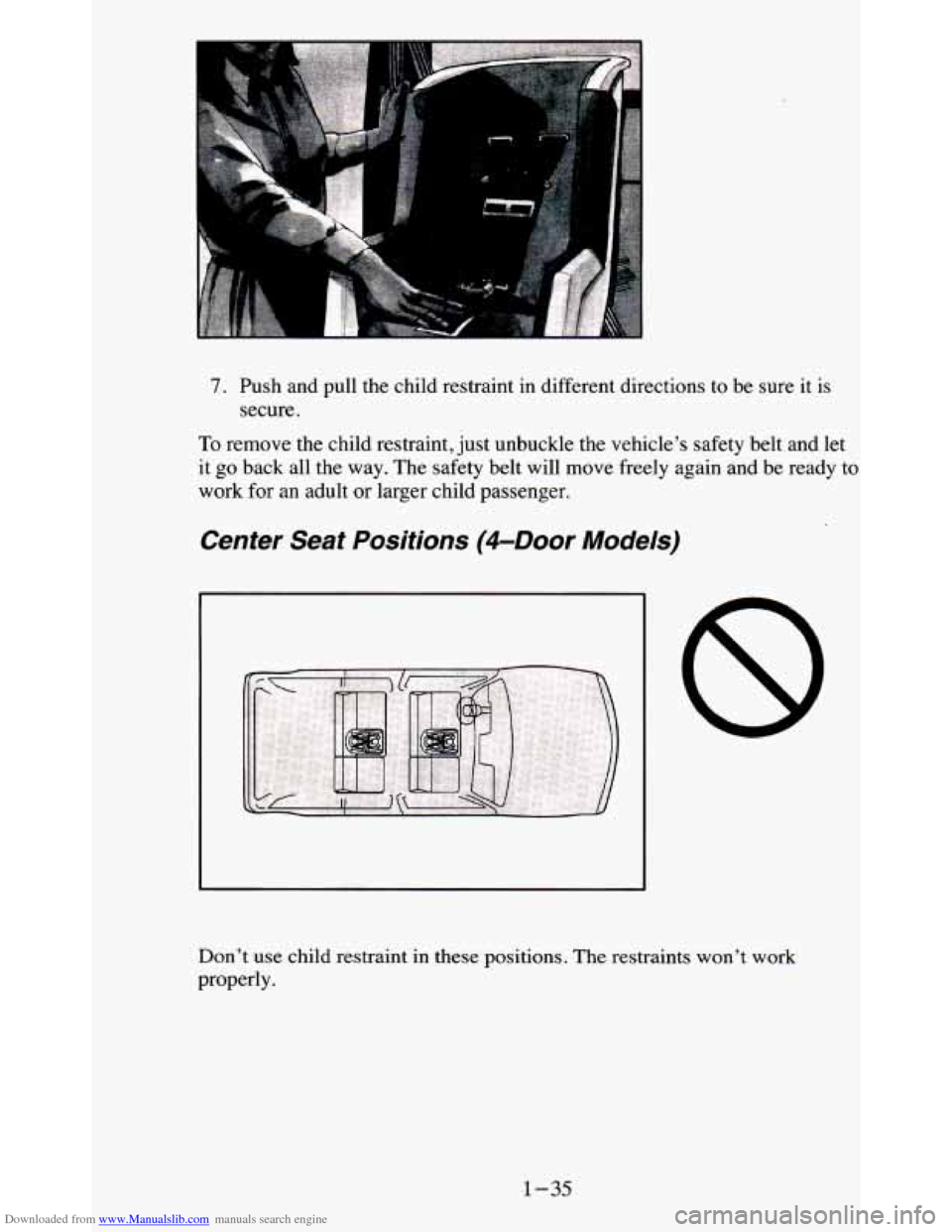
Downloaded from www.Manualslib.com manuals search engine 7. Push and pull the child restraint in different directions to be sure it is
secure.
To remove the child restraint, just unbuckle the vehicle’s safety belt and let
it
go back all the way. The safety belt will move freely again and be ready to
work
for an adult or larger child passenger.
Center Seat Positions (&Door Models)
Don’t use child restraint in these positions. The restraints won’t work
properly.
1-35
Page 46 of 380
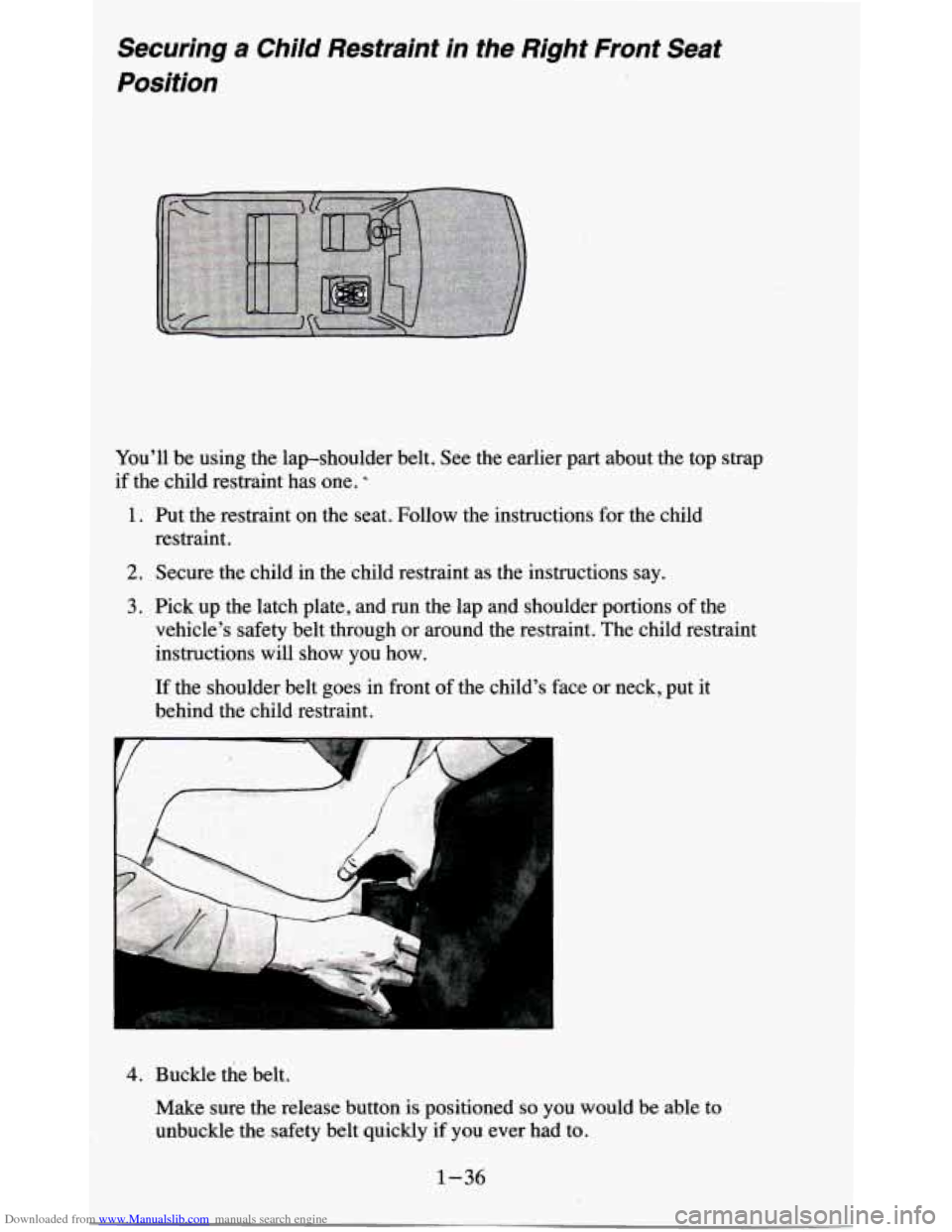
Downloaded from www.Manualslib.com manuals search engine Securing a Child Restraint in the Right Front Seat
Position
You'll be using the lapshoulder belt. See the earlier part about the top strap
if the child restraint has one.
1.
2.
3.
Put the restraint on the seat. Follow the instructions for the child
restraint.
Secure the child in the child restraint as the instructions say.
Pick up the latch plate, and run the lap and shoulder portions
of the
vehicle's safety belt through or around the restraint. The child restraint
instructions will show you how.
If the shoulder belt goes in front of the child's face or neck, put it
behind the child restraint.
4. Buckle the belt.
Make sure the release button is positioned
so you would be able to
unbuckle the safety belt quickly
if you ever had to.
1-36
Page 47 of 380
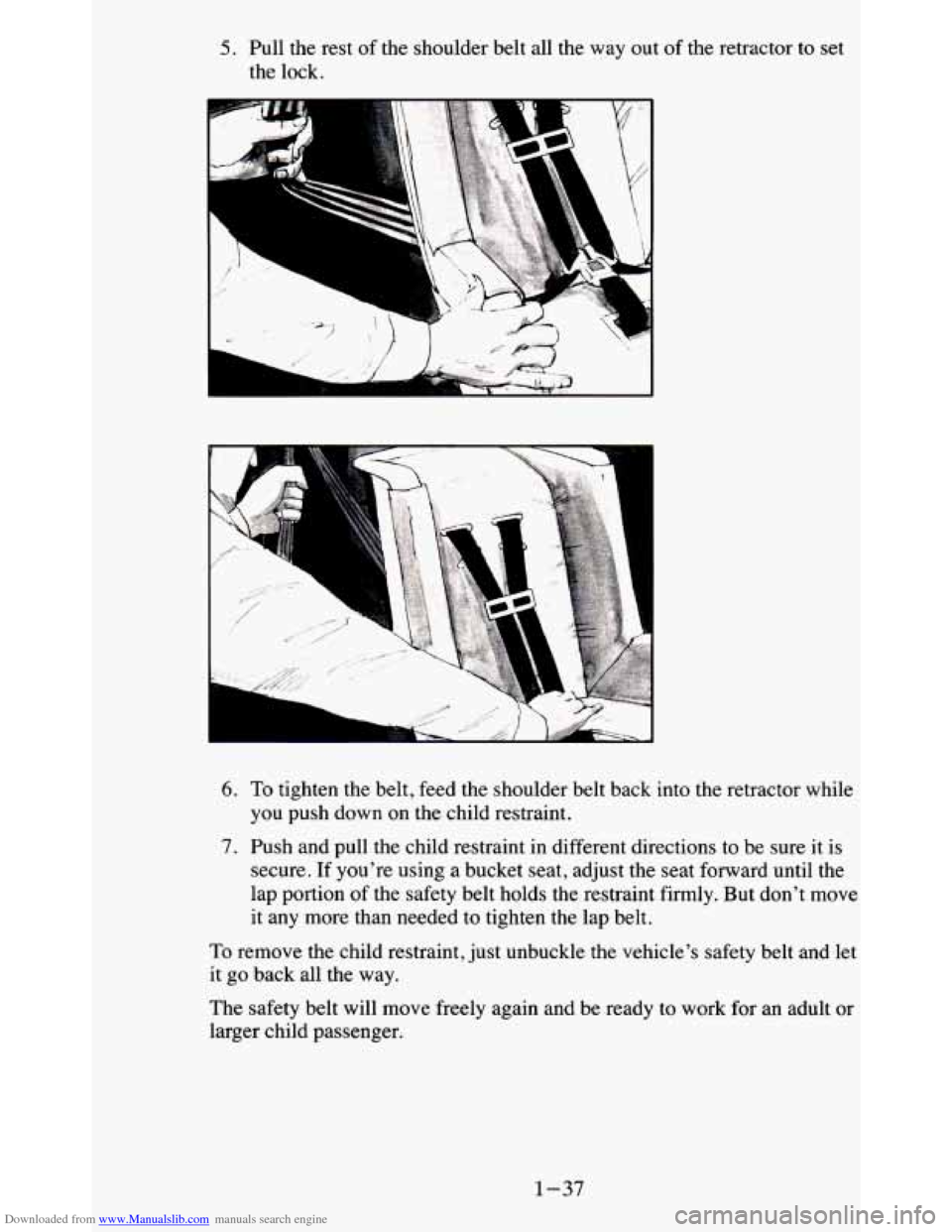
Downloaded from www.Manualslib.com manuals search engine 5. Pull the rest of the shoulder belt all the way out of the retractor to set
the lock.
Lsi
II
11
-, -
1
I
i
6. To tighten the belt, feed the shoulder belt back into the retractor while
you push down on the child restraint.
7. Push and pull the child restraint in different directions to be sure it is
secure. If you're using a bucket seat, adjust the seat forward until the
lap portion
of the safety belt holds the restraint firmly. But don't move
it any more than needed to tighten the lap belt.
To remove the child restraint, just unbuckle the vehicle's safety belt and let
it
go back all the way.
The safety belt will move freely again and be ready to work for an adult or
larger child passenger.
1-37
Page 48 of 380
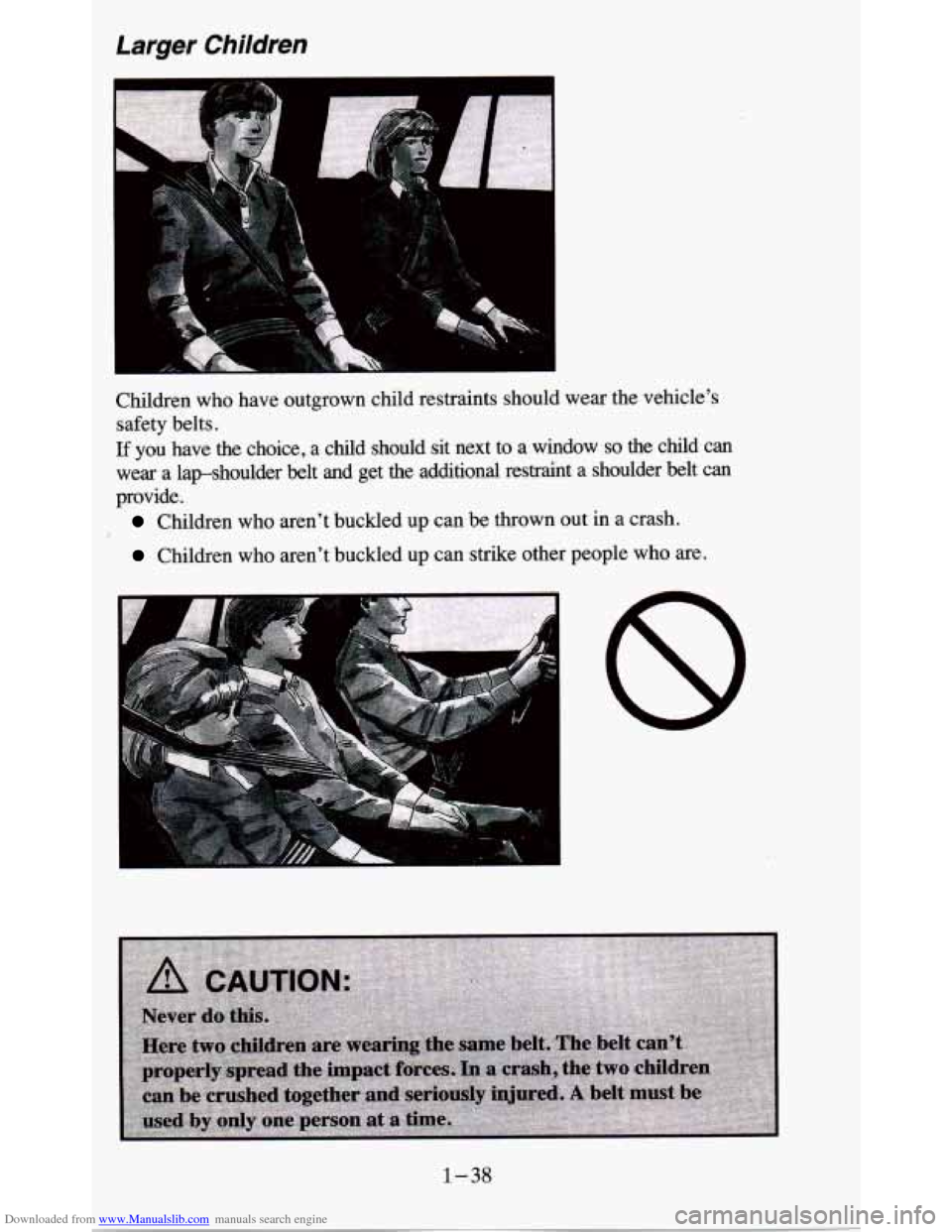
Downloaded from www.Manualslib.com manuals search engine Larger Children
1
Children who have outgrown child restraints should wear the vehicle’s \
safety belts.
If you have the choice, a child should sit next to a window so the child can
wear a lapshoulder belt and get the additional restraint a shoulder belt can
provide.
Children who aren’t buckled up can be thrown out in a crash.
Children who aren’t buckled up can strike other people who are.
1-38
Page 49 of 380
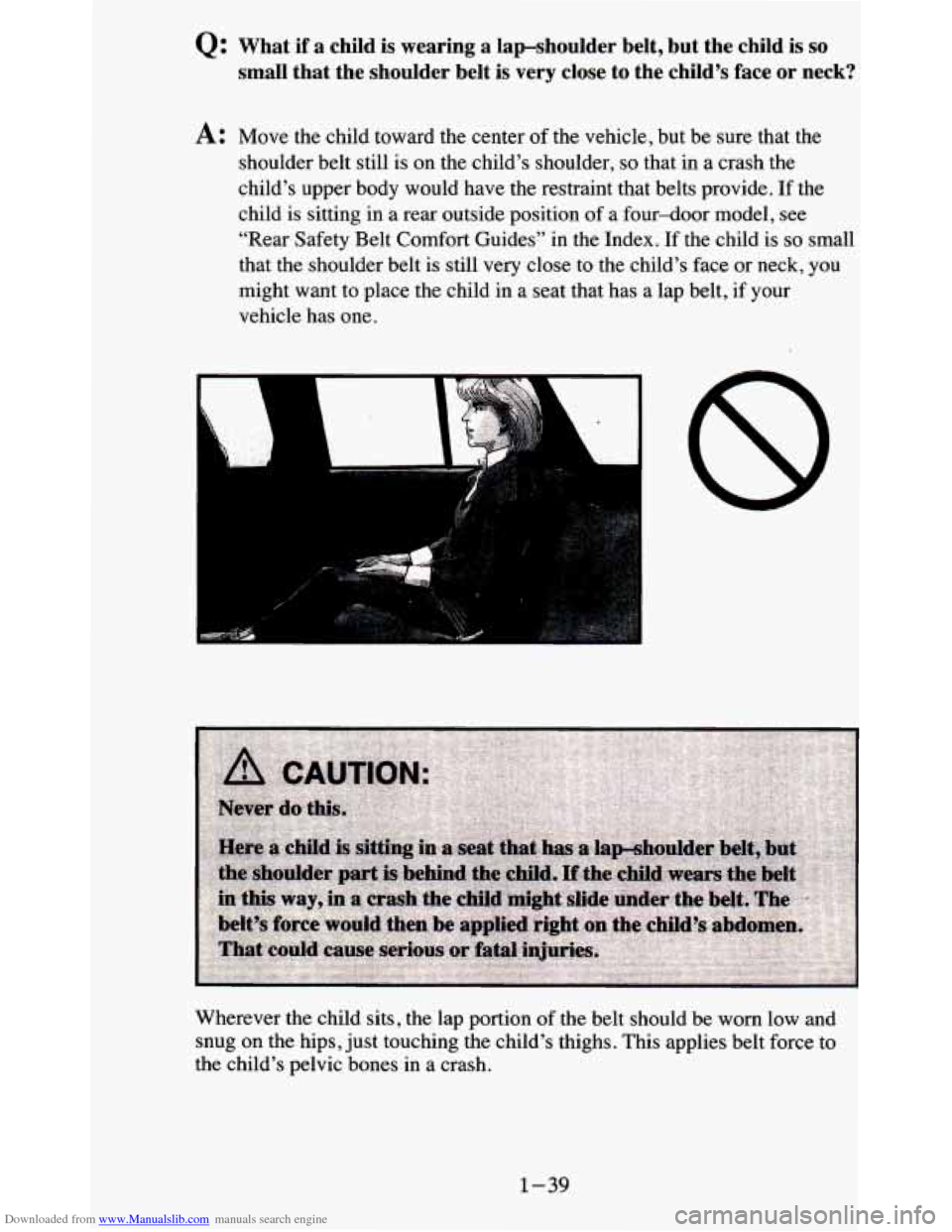
Downloaded from www.Manualslib.com manuals search engine Q: What if a child is wearing a lapshoulder belt, but the child is so
small that the shoulder belt is very close to the child’s face or neck?
A: Move the child toward the center of the vehicle, but be sure that the
shoulder belt still is on the child’s shoulder,
so that in a crash the
child’s upper body would have the restraint that belts provide. If the
child is sitting in a rear outside position of a four-door model, see
“Rear Safety Belt Comfort Guides” in the Index. If the child is
so small
that the shoulder belt is still very close to the child’s face or neck, you
might want to place the child in a seat that has a lap belt, if your
vehicle has one.
Wherever the child sits, the lap portion of the belt should be worn low and
snug on the hips,
just touching the child’s thighs. This applies belt force to
the child’s pelvic bones in a crash.
1-39
Page 50 of 380
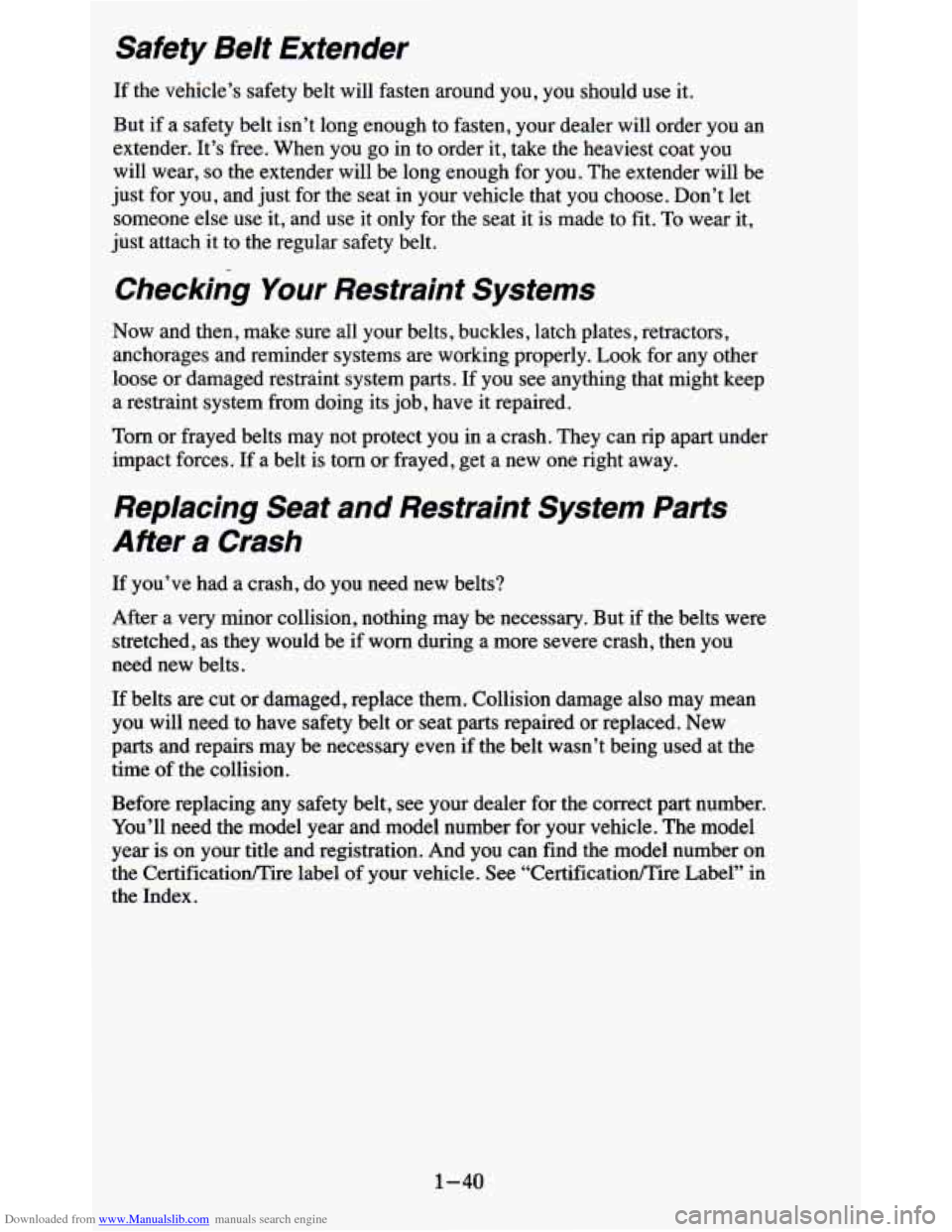
Downloaded from www.Manualslib.com manuals search engine Safety Belt Extender
If the vehicle’s safety belt will fasten around you, you should use it.
But
if a safety belt isn’t long enough to fasten, your dealer will order you an
extender. It’s free. When you go in to order it, take the heaviest coat you
will wear,
so the extender will be long enough for you. The extender will be
just for you, and just for the seat in your vehicle that you choose. Don’t let
someone else use it, and use it only for the seat it is made to fit.
To wear it,
just attach it to the regular safety belt.
Checking Your Restraint Systems
Now and then, make sure all your belts, buckles, latch plates, retractors,
anchorages and reminder systems are working properly.
Look for any other
loose or damaged restraint system parts. If you see anything that might keep
a restraint system from doing its job, have it repaired.
Torn or frayed belts may not protect you in a crash. They can rip apart under
impact forces. If a belt is torn or frayed, get a new one right away.
Replacing Seat and Restraint System Parts
After
a Crash
If you’ve had a crash, do you need new belts?
After a very minor collision, nothing may be necessary. But if the belts were
stretched, as they would be if worn during a more severe crash, then you
need new belts.
If belts are cut or damaged, replace them. Collision damage also may mean
you will need to have safety belt or seat parts repaired or replaced. New
parts and repairs may be necessary even if the belt wasn’t being used at the
time of the collision.
Before replacing any safety belt, see your dealer for the correct part number.
You’ll need the model year and model number for your vehicle. The model
year is on your title and registration. And you can find the model nu\
mber on
the Certificatioflire label of your vehicle. See “Certificatioflire Label” in
the Index.
1-40